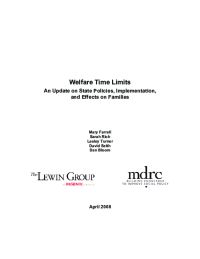An Update on State Welfare Time-Limit Policies and Their Effects on Families
One of the most controversial features of the 1990s welfare reforms was the imposition of time limits on benefit receipt. Time limits became a central feature of federal policy in the landmark 1996 welfare law, which created the Temporary Assistance for Needy Families (TANF) block grant. The law prohibits states from using federal TANF funds to assist most families for more than 60 months. Under contract to the Administration for Children and Families (ACF) in the U.S. Department of Health and Human Services, The Lewin Group and MDRC have conducted a comprehensive review of what has been learned about time limits. The review, which updates a 2002 study, includes analysis of administrative data reported by states to ACF, visits to several states, and a literature review. The update is timely because most states now have several years’ experience with time limits.
Federal law affords states great flexibility in setting time-limit policies. The federal 60-month limit does not apply to state-funded benefits; also, states may use federal TANF funds to support up to 20 percent of the caseload beyond 60 months. Thus, states may set a 60-month time limit, a shorter limit, or no time limit, and they may choose to exempt families from time limits. Not surprisingly, time-limit policies vary dramatically from state to state. Other key findings from the study include:
- Nationally, a large proportion of TANF households are not subject to time limits, but time limits play a key role in some states. About 44 percent of TANF households are not subject to federal or state time limits because they are “child-only cases” — typically, children living with a relative or families in which the parent is not eligible for benefits. In addition, about half of TANF families live in states that rarely or never close families’ cases because of time limits. On the other hand, a quarter of TANF families live in states that usually terminate benefits after 60 months, and nearly as many are in states with shorter limits.
- Nationally, at least a quarter million TANF cases have been closed due to reaching a time limit since 1996, although about one-third of these closures have occurred in New York, which routinely transfers cases to a state and locally funded program that provides the same amount of benefits as TANF. Most other states do not routinely provide such post-time-limit assistance. It is important to note that time-limit closures account for only 2 to 3 percent of all closures in a typical month. Recipients whose cases are closed due to time limits differ from other welfare leavers in key ways; for example, they are less likely to have a high school diploma and are more likely to live in subsidized housing.
- Many of the families whose TANF cases were closed due to time limits are struggling financially and report being worse off than they were while on welfare. Several state surveys have found that many families whose cases were closed due to time limits are experiencing material hardships and are still relying heavily on other forms of public assistance, such as food stamps. However, it is not clear that families who left TANF because of time limits are struggling more than other welfare leavers, most of whom remain poor as well.
Overall, it appears that time limits have not generated as much attention or hardship as some predicted. This is in part because several large states do not have stringent time-limit policies; also, other policies — such as stricter penalties for noncompliance with work requirements — affect more families. Nevertheless, it is important to keep following the story of time limits, especially as states redesign their programs in response to the reauthorization of TANF in 2005.







